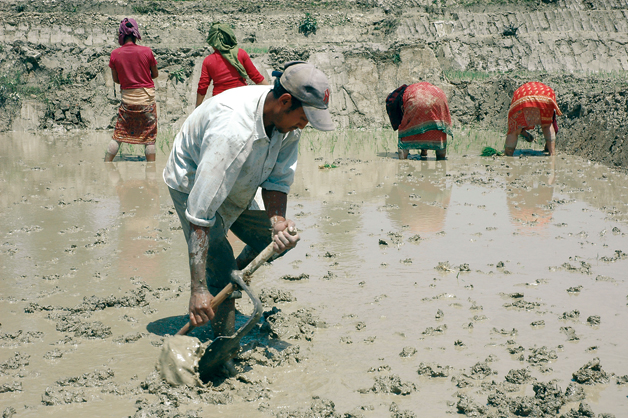
It is common practice for Nepali people who are looking for work or for a position in any office or business to declare that they are seeking a Jagir. People leaving for their offices in the morning will tell you they are going to earn their Jagir. Young men desperately look for a Jagir as the final qualification to get married. Today, Jagir just means a steady job that fetches you a monthly salary whether you are productive or not. The history of this term must be understood to truly understand the meaning of power, poverty, domestic labor and corruption.
The late Dr. Mahesh Chandra Regmi, well-known economics historian, defined Jagir as “an official post” and also as “the assignment of land and other sources of income in lieu of cash salaries.” The feudal mindset and the need to appease those above you, comes from the fact that historically, Jagir land could not be sold, inherited, transferred or subdivided, because government employees and the military personnel were traditionally appointed only for a year at a time. The Jagir land automatically reverted to the state at the end of this term. The annual ceremony where your Jagir was confirmed for one more year was called Pajani. There was no incentive to take care of or invest in such land.
What made Jagir very attractive to the Nepali in the 19th century was that there were rights and privileges associated with the land grant. These included the right to a share of the produce of the land, the right to the proceeds of taxes and fees levied on the inhabitants of that land, the right to extract unpaid labor on a compulsory basis from the farmers, and the most important, the right to dispense justice. Even to this day, my children are officially my children only if a government Jagir holder says so. Women below 35 can get a passport only if he/she says she can.
Jagir had to be renewed each year, which meant no job security of any kind. Further, every few years, the rulers assigned you to a different land because they did not want you to create a power base. It is probably with this historical background that secretaries in the government ministries and even village teachers keep getting transferred each year. Offices and buildings are kept in a poor state probably because of the prior knowledge that one is going to be transferred “soon”.
The word Jagir has its origins in Moghul India and was defined in those days (16th century) as revenue right over specified lands as granted by a Moghul ruler to one of his Amirs (nobles) for the maintenance of troops. The Jagirdar is the person who holds the Jagir. It was the way Moghul rulers of India generated great wealth through land and labor. While the basic idea has always been to take away only the surplus, history teaches us that in the subcontinent, the rulers took away as much as they could and left as little as possible for the farmers to survive on. This was the reason why farmers were poor.
According to Dr. Mahesh Chandra Regmi, in the 19th century the powerful elite in Nepal was paid quite well through the Jagir system. While the army was willing to provide loyalty for less than NRs 60/- a year, Mathbar Singh Thapa who was the nephew of the then Prime Minister Bhimsen Thapa (1806-37 AD) had an annual income of NRs. 10,120/- as his Jagir. He was assassinated in 1845 and all his assets confiscated.
The Jagir system only served the civil servant or the military personnel and they in turn had no interest in investing anything back on the land or the farmer. The farmer was completely dependent on rain for irrigation. In the years 1863-66 AD, the monsoons failed and there was widespread famine across Nepal. Dr. Mahesh Chandra Regmi writes that when the government attempted to raise relief funds from the Jagirdar elite, only NRs.6000/- was mobilized, while besides Jagir land, the hereditary (Birta) land revenue from the tarai alone was NRs.900,000/- a year!
Further, from 1852-53 AD, the use of tarai land for Jagirs was ended because money went to individuals and not to the state. During the rule of Jung Bahadur Rana (between 1854 to 1868), land surveys were done and for the first time, taxation levels were fixed. He also ended the system that enabled a Jagirdar to oust a farmer for someone else who offered to pay a higher amount. The tax was one third of the crops in the tarai and the west, while in the rest of the country it was 50 percent or more!
Today that same “Jagir mentality” prevails in the Nepali offices. It is their job to generate as much revenue as possible from their position of authority and power. You have to only please those above you, so you can remain in that position for as long as you can. If the “patron” is not pleased, you get transferred to places where you will earn less. Many people who speak of a “new Nepal” need to understand the “Jagir” heritage. As history teaches us, Jagir revenue is not to make Nepal rich but to make yourself rich, and to share it with those above you, so you can retain the Jagir.
Anil Chitrakar is a founding member of Kathmandu 2020 and
has launched Crafted in Kathmandu to help local artisans.
For comments e-mail: rosha@craftedinkathmandu.com











